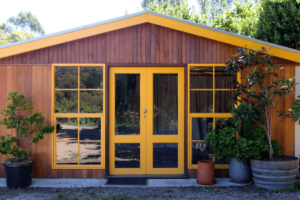
Plant stylist Emma Sadie Thomson looked every day at the unused shed outside the entrance to the home where she lived with her partner and their two young daughters in the Adelaide Hills. Could it be a better place to work than the kitchen table, where her children and housework provided constant distractions?
“It was just a junk heap,” says Thomson. “We never used it. I wanted somewhere to go, even if it’s taking 20 steps, rather than sitting on the kitchen table.” She decided to convert the shed into a studio. Aiming to spend no more than $10,000, Thomson opted for recycled materials for the windows, door, and wood exterior panelling.
Working with plants has shaped Thomson’s worldview over the years, highlighting the need for sustainability in all aspects of life. Her instinct was to use salvaged materials when possible. The Australian construction industry generates more than 12m tonnes of waste a year. According to the Australian Bureau of Statistics, the construction industry generated the second largest amount of solid waste in Australia in 2020, behind manufacturing. Thomson saw secondhand goods as a way to not only reduce building waste but eliminate excess packaging.
Thomson’s mother had the good fortune of finding some cedar panels in incredibly good condition in a skip. All they needed was a quick oiling and varnish. They didn’t quite cover the entire front of the shed, so Thomson used them on the section above the support beam. For the section below, which would frame the doors, Thomson ordered some new cedar panels, creating a flattering juxtaposition of the two woods. The doors and windows were also secondhand, from a salvage shop up the road.
Inside, Thomson’s main concern was how to insulate. From a friend who was working for Joost Bakker’s Future Food System project in Melbourne, Thomson learned about Durra Panel, a wheat straw insulation, originally designed in Sweden and made in Bendigo, and decided to use it for the inside walls and ceiling. Wheat straw for Durra panels comes specifically from what is known as ‘stubble’ from food crops. This significant agricultural by-product – consider that the world produces around 680m tonnes of wheat annually – would typically be burned, contributing to carbon dioxide pollution. Durra sources its wheat straw from within 100 kilometres of its Victorian factory, which has the local effect of reducing this burning in the immediate area.
Thomson was aware that straw was a waste material across the world.“[It] is a great building solution, which provides alternative incomes for farmers.” She liked the idea of using an underappreciated natural material that also has fire resistant properties. Using a process that activates the straw’s naturally high lignin content allows the straw to stick together in this way, earning a fire resistant level of one hour. With bushfires a seasonal threat in the Adelaide Hills, a structure’s fire resistance was always an important consideration.
Durra had been using [the panels] mostly for commercial projects, but they wanted people to take it up for residential,” says Thomson. Price-wise, running about $4,000 (nearly half her budget), Durra’s product was somewhat higher than other insulations, but the shed was small enough (about 48 sq m) that the difference wasn’t so significant, and the use of biowaste increased the product’s value in an ethical sense.
